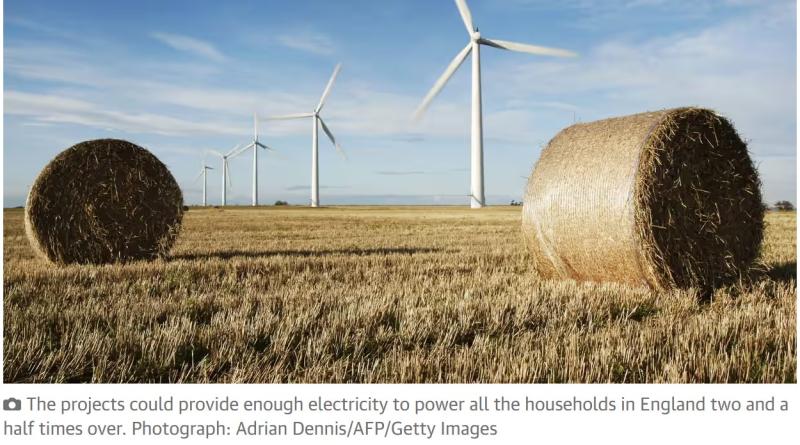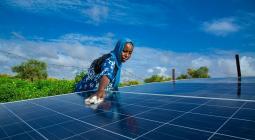England could produce 13 times more renewable energy, using less than 3% of land – analysis

England could produce 13 times more renewable energy than it does now, while using less than 3% of its land, analysis has found.
Onshore wind and solar projects could provide enough electricity to power all the households in England two and a half times over, the research by Exeter University, commissioned by Friends of the Earth (FoE), suggested.
Currently, about 17 terawatt hours of electricity a year comes from homegrown renewables on land. But there is potential for 130TWh to come from solar panels, and 96TWh from onshore wind.
These figures are reached by only taking into account the most suitable sites, excluding national parks, areas of outstanding natural beauty, higher grade agricultural land and heritage sites.
Some commentators have argued that solar farms will reduce the UK’s ability to grow its own food, but the new analysis suggests there is plenty of land that can be used without impairing agricultural production. More land is now taken up by golf courses than solar farms, and developers can be required to enhance biodiversity through simple measures such as maintaining hedgerows and ponds.
Onshore windfarms were in effect banned in 2015 by the then prime minister, David Cameron. Rishi Sunak last year claimed to make moves towards lifting the ban, through small changes to the planning regulations, but campaigners say they were ineffectual and real planning reform is needed. No plans were submitted for new windfarms in England last year, and few new developments are coming forward, despite high gas prices, rising bills and onshore wind being the cheapest form of electricity generation.
The calculations of the land needed exclude rooftop solar panels. Ministers have resisted calls for solar panels to be made mandatory on new-build housing. Kitting out a new-build home with renewables, high-grade insulation and other low-carbon features costs less than £5,000 for a housing developer, but retrofitting it to the same standard costs about £20,000, with the cost borne by the householder. Housing developers are among the largest donors to the Conservative party.
FoE has produced a map that shows potential sites for onshore wind and solar generation. North Yorkshire, Lincolnshire and the East Riding of Yorkshire show particularly good potential. The sites total about 374,900 hectares (926,400 acres), or about 2.9% of the available land in England.
Tony Bosworth, climate campaigner at Friends of the Earth, said: “Unleashing the UK’s immense potential to generate cheap, clean homegrown renewables is essential to bring down our energy bills for good and meeting the UK’s vital international target to reduce carbon emissions by two-thirds by 2030. But the current government’s record on boosting our energy security through renewables is woefully inadequate and has left the UK lagging far behind in the global race to a zero-carbon economy. Meanwhile, Labour is looking increasingly shaky on climate after rolling back its planned investment in green growth.”
He called on all the main parties to commit to lifting restrictions on onshore windfarms in England; for local authorities to identify suitable areas for renewable development; for upgrades to the electricity grid to enable the vast expansion of renewable energy; and for tougher requirements on renewable developers to protect biodiversity.
Local communities can also be helped to benefit from renewable developments, for instance through being offered cheaper power or a share in the development.
Bosworth said: “We urgently need our political leaders to pull their heads out of the sand and produce a strong, ambitious and fair new climate plan that lifts the barriers to onshore wind and solar power and secures investment in the infrastructure needed to support the switch to renewables. These are win-win policies for creating long-term jobs, boosting our ailing economy and protecting our planet for future generations.”
A Department for Energy Security and Net Zero spokesperson said: “Onshore wind power capacity has almost quadrupled since 2010 and renewables account for nearly half of our electricity, up from just 7%. We’ve also streamlined planning rules in England to make it easier for councils to identify suitable land for onshore wind. Our latest renewables auction has its largest ever budget of £1bn, including a record £800m pot for offshore wind, to further strengthen our world-leading clean energy sector, supporting a range of renewables from onshore wind to solar.”





